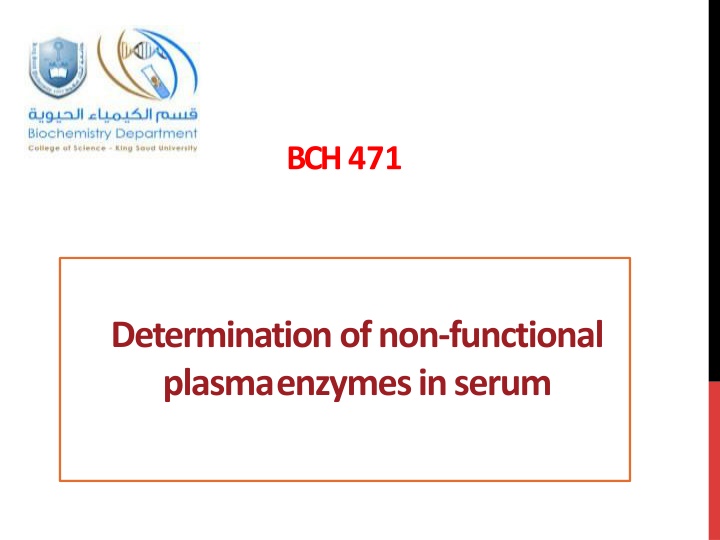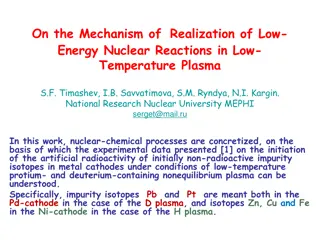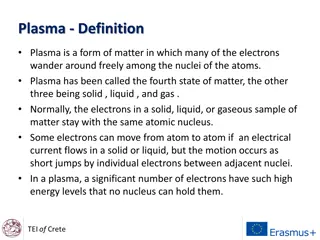
Non-Functional Plasma Enzymes: ALT Levels in Serum
Explore the significance of determining non-functional plasma enzymes, focusing on alanine transaminase (ALT) levels in serum to assess tissue damage. Learn about the differences and sources of functional versus nonfunctional enzymes, as well as the medical importance of measuring non-functional enzymes for disease diagnosis and treatment monitoring. Discover the role of ALT in amino acid production and its diagnostic relevance in liver-associated conditions.
Download Presentation

Please find below an Image/Link to download the presentation.
The content on the website is provided AS IS for your information and personal use only. It may not be sold, licensed, or shared on other websites without obtaining consent from the author. If you encounter any issues during the download, it is possible that the publisher has removed the file from their server.
You are allowed to download the files provided on this website for personal or commercial use, subject to the condition that they are used lawfully. All files are the property of their respective owners.
The content on the website is provided AS IS for your information and personal use only. It may not be sold, licensed, or shared on other websites without obtaining consent from the author.
E N D
Presentation Transcript
BCH 471 Determination of non-functional plasmaenzymes in serum
Objectives To determine the level of alanine transaminase (ALT) in serum. To evaluate the presence of tissue damage.
Most clinical enzyme measurements using serum or plasma, occasionally other fluids, such as urine and gut secretions, are investigated. Plasma Enzymes Functional Plasma Enzymes Nonfunctional Plasma Enzymes Enzymes that are always present in the circulation and preform a function in the blood Enzymes that preforms no known function in blood
Differences of Functional and Nonfunctional plasmaenzymes Functional plasma enzymes Nonfunctional plasmaenzymes Always present in the blood Absent from the blood Their substrate Liver Different organs e.g. liver, heart, muscles, and brain Site of synthesis Decrease in liver diseases Different enzymes increase in different organ diseases ALT LDH Acid Phosphatase Amylase Effect of diseases Clotting factors Lipoprotein Lipase Examples
SourcesofNonfunctionalPlasmaEnzyme Cell damage with the release of its content of enzymes into blood e.g. Myocardial infarction and viral hepatitis Obstruction of normal pathways e.g. Obstruction of bile duct increases alkaline phosphatase Increase of the enzyme synthesis e.g. bilirubin increases the rate of synthesis of alkaline phosphatase in obstructive liver disease Increased permeability of cell membrane as in hypoxia
Medical Importance of Non Functional Plasma Enzymes Measurement of non functional enzymes is important for: Diagnosis of diseases Prognosisof the disease: following up of the treatment by measuring plasma enzymes before and after treatment.
Alanine transaminase ALT is an enzyme that catalyzes a type of reaction (transamination) between an amino acid and -keto acid. It is important in the production of various amino acids.
ALT diagnostic importance ALT is found in serum (at low level) but is most commonly associated with the liver. thus , an elevated level ALT is a sensitive index of acute hepatocellular injury. Elevated serum ALT (SGPT) level are found in hepatitis, cirrhosis , and obstructive jaundice. Levels of ALT are only slightly elevated in patient following a myocardial infraction.
Method Tube 3 ml ALT reagent Pre-warm at 37 oC for 3 minutes and add 200 l Sample (serum) Mix and incubate at 37oC for 1 minutes, then read the absorbance at 340 nm against distilled water (blank) every minute for 3 minutes and determine A/min. 2) Applications Duration (120 sec = 2 min) (off) Press start (2 times) 2) Simple Kinetics wave length (340 nm) Intervals (60 sec= 1 min) 1) Seconds Print Data Table
Results Absorbance at 340nm Time(min) A1 1 A2 2 A3 3
Calculations A1, = A1 A2 # A/min = ( A1 + A2) /2 A2 = A2 A3 A L T (U/L)= A x1768 NormalV alues Males: up to 42( U/L) Female: up to 32( U/L)





















